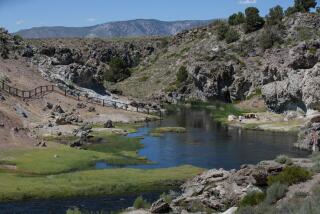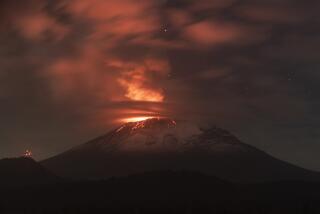A Hot Topic for Volcanologists
TEMPE, Ariz. â With the Popocatepetl volcano near Mexico City erupting regularly, sending ash 150 miles to Veracruz on the coast of the Gulf of Mexico and raining hot rocks down its slopes, a conference of 27 scientists here gained in urgency.
The volcanologists, many from the Third World, came together recently to learn more about operating the complicated COSPEC instrument, which has had many functions since its debut in the 1960s and is now often used to measure volcanic gas emissions.
Some scientists, such as the host of the conference, Arizona State University professor Stanley Williams, believe that by studying the pattern of such emissions, particularly sulfur dioxide, scientists will be able to more accurately predict the course of eruptions.
The situation at the 17,887-foot Popocatepetl may provide a crucial test of the usefulness of COSPEC--short for the last two words of its scientific name, Absorption Correlation Spectrometry.
Science is rarely easy, and the struggle to use the instrument properly and maximize its value illustrates the point.
The $50,000, 44-pound device, manufactured by Barringer Instruments Ltd., of Canada, measures gaseous plumes by analyzing skylight through a front-mounted telescope.
For sulfur and nitrogen dioxide, it can determine emission, dispersion, depletion and rise rates, but according to lectures here and techniques of analyzing plumes demonstrated over several days in the vicinity of a power plant near Page, Ariz., such factors as the time of day, angles of surveillance, clouds and variation of radiation can all distort the results.
Working it correctly in relation to these factors, and calibrating it frequently, are essential to getting valid results, said Millan Millan, a science professor from Valencia, Spain, who is an expert on operating the instrument.
After Millan repeatedly admonished the other scientists âto calibrate as frequently as possibleâ to try to hold uncertainty in the data down to 5%, one asked him whether it was possible to calibrate (to use a known concentration of gas as a standard of comparative measurement) too often.
âToo often is not often enough,â the professor replied.
Among those attending the conference was Hugo Delgado of the National University of Mexicoâs Institute of Geophysics. Delgado has been monitoring Popocatepetl since it resumed eruptive activity, after 67 years of quiet, on Dec. 21, 1994.
His is a touchy job because Mexican government authorities have repeatedly played down the chances for a major, destructive eruption at a mountain which, deposits show, has had catastrophic eruptions in the past. As little as 1,100 years ago, an eruption occurred that sent mudslides cascading onto areas now inhabited by millions of people.
It was Delgado who reported in February that sulfur dioxide emissions from the mountain, nicknamed âPopo,â had briefly reached an unheard-of level of 120,000 metric tons a day.
Some scientists argued this presaged a sizable eruption, but nothing major happened immediately. In April, when eruptions did grow in size, Delgado said the emissions had dropped back to a still-significant 8,000 metric tons a day.
After the conference, Williams organized a new expedition to Mexico to measure the gas emissions with the most advanced COSPEC device yet developed.
âPopo keeps saying relentlessly that there is a large amount of magma [molten material] down there,â Williams said before leaving. âThe gas flux [emission rate] shows it. Eight thousand tons a day of gas is not a negligible number. It could potentially be a very large eruption.â
But, Williams added paradoxically, as long as the sulfur dioxide gas was being emitted freely, it meant the mountain was open and explosive pressure was not building.
âIf the gas lines inside the mountain become clogged and it cannot de-gas, then there could be serious explosions,â he said. âSo if COSPEC suddenly shows gas emissions decreasing, if Popo gets into being quiet, then I would make sure my distance from the crater was substantial.â
Williams was on scene by May 7 and reported his first readings: lower sulfur dioxide emissions in the range of 4,000 to 6,000 tons a day. This suggested âit would pop soon,â he said.
When the largest eruption yet occurred May 11, he felt COSPEC had worked. He added that he believed the eruption would open the vents and increase gas emissions, thus causing eruptive activity to cease for the time being.
It is only when the readings decline again, he predicted, that the next eruption would be on the way.
Still, much further study is needed, including recording the progression of events at many volcanoes, before scientists will be able to calculate what level of emissions presage a truly major eruption.
Popocatepetl, 39 miles southeast of Mexico City, has had 16 eruptions since the arrival of Cortez in Mexico in 1519, yet none has been catastrophic. Only if one occurs now will there be a telltale scientific record, in terms of gas emissions, of what led up to it.
One of the advantages of the measuring instrument is that it can take emissions readings from the air or on the ground from a distance. Scientists need not enter the dangerous crater to get the numbers.
More than 180 instruments are in use worldwide, and, in addition to aiding volcano studies, they have proved valuable in analyzing the size and reach of plumes of pollutants from manufacturing and power plants.
One discovery resulting from this aspect of its use is that plumes are âgoing much further than we ever imagined,â Millan said.
The Spanish scientist said that COSPEC studies show, for instance, that plumes of pollutants formed in Los Angeles shoot up the side of the San Gabriel Mountains, get on top of local inversion layers, and then, at heights that may exceed 12,000 feet, are swept by winds âall the way down to Texas and then up to New Jersey.â






